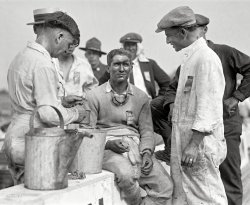
MAY CONTAIN NUTS

Search Shorpy
SHORPY ART

Framed or unframed, desk size to sofa size, printed by us in Arizona and Alabama since 2007. Explore now.
Join and Share
Ad-Free Shorpy
Shorpy is funded by you. Patreon contributors get an ad-free experience.
Learn more.

Recent comments
- Hudson’s Big Store
- Say what??
- Grapes?!
- A Beautiful Moment
- Such joy
- Bethune-Cookman University today...
- Yellow sky at morning
- Side Winder
- Air Quality?
- Sojourner Truth riot
- None were so blind(ed)
- The less famous sister
- Good ol' days?
- Rise and Fall
- Goo Goo Ga Joob
- Ticket Retention
- Not the only one
- Vagaries of War
- Killed by Amtrak
- Back to the Future
- Wanted --
- If you can't stand the light
- Centralized Traffic Control, I believe
- What's really happening
- Heckuva remote control!
- Sometimes — Things Go Bump!
- I SEE THE LIGHT
- Union Switch and Signal Company
- Get That Light Out Of My Eyes
- Eggs. Eggs. Eggs. The Egg Man is Here!
Member Photos
The Shorpy
Print Emporium
Print Emporium
Search Shorpy
Search results -- 30 results per page
- Tops and Trimmings: 1921
- ... it is linked to the earlier Alter Car that was made by the Cincinnati Motors and Manufacturing Company, but there doesn't seem to be any physical evidence for that, and the Cincinnati firm did not go out of business until its founder died in early ... Posted by Dave - 08/07/2012 - 3:07am -
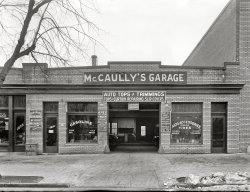
- Lena Again: 1908
- August 1908, Cincinnati. "Lena Lochiavo, 11 years old, Basket Seller, Sixth Street Market. ... decent life after all. What a country!!
(The Gallery, Cincinnati Photos, Kids, Lewis Hine, Stores & Markets) ... Posted by Dave - 08/08/2011 - 10:30pm -
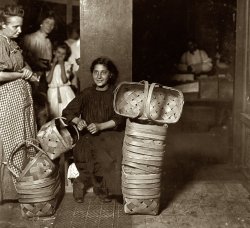
- Train Wreck: 1900
- 1897-1901. "Cincinnati, Hamilton & Dayton R.R. train wreck below Dayton, Ohio." 4x5 ... October 20, 1897 wreck between the southbound Toledo and Cincinnati Express, and the northbound freight 30 of the Cincinnati, Hamilton, and Dayton on board which was Bishop Milton Wright, the ... Posted by Dave - 01/12/2018 - 10:26pm -
![Train Wreck: 1900 1897-1901. "Cincinnati, Hamilton & Dayton R.R. train wreck below Dayton, Ohio." 4x5 glass negative attributed to Wilbur and/or Orville Wright. View full size.
CounterintuitiveThough not standard construction, quite a few 4-6-0 and 4-8-0 type engines, such as we are herein viewing from underneath, were built with blind leading drivers, as it was felt that the four wheel leading truck provided sufficient stability to obviate flanges on them, even at high speed.
Omitting this flange allowed the locomotive to better negotiate very sharp curves and turnouts at slow speed in yards and enginehouse areas.
Lack of this flanged driver was not a factor in this "head-on" collision. This was the result of a dispatching error or of misinterpretation by one of the engineers of the timetable or of the dispatchers instructions.
It's truePeople DO love to stare at a train wreck.
3 ThingsThere are three things I noticed. The blind drivers (no flanges) are on the leading drive axle. All the ones I've seen would have been on the center axle.
The monkey wrench laying next to the rail is identical to the one I have that came from The Milwaukee Road many decades ago.
The joint bolts in the rail have the nuts all on the same side. Standard practice now is to alternate sides. I assume the idea is to prevent them from all being sheared off by a derailed wheel. The bolt heads are a button type that a wheel would slide past without damage.
Is This Not Their Father's Wreck?Isn't this the October 20, 1897 wreck between the southbound Toledo and Cincinnati Express, and the northbound freight 30 of the Cincinnati, Hamilton, and Dayton on board which was Bishop Milton Wright, the father of the famous Wright Brothers? See this.
Front drivers were never blindOnly some very early rigid framed 4-4-0's of the mid 1800s experimented with using blind front drivers to negotiate sharper curves. It was not a practice continued on other locomotives as swinging pilot trucks would not keep a blind front driver on the rails.
On larger engines in the early 1900's blind center drivers were used but in following years better lateral motion devices and improved track geometry all but ended the practice. Once a locomotive was well wore in it was still possible to drop a blind center driver off the rails on a sharp curve and many locomotive rebuilds included putting flanged tires back on.
More than likely in this instance in the moments preceding the wreck the brakes were applied sufficiently to heat up the tires on the locomotive which expanded them and they have come off the wheels. As you can see the side rods have been removed and likely the loose tires from the front axle have been removed or broke during the wreck.
Monkey wrenchI also have a monkey wrench like the one that Alan spotted. It is all forged and machined. The adjuster has square threads and the wooden handles were hand fitted as well as if they were done by a gunsmith. Modern tools do not compare.
A Line of ____Upper right background, there is a line of objects giving the appearance of a string of box cars. Small cabins, maybe?
[Looks like a split-rail zigzag fence. -tterrace]
This is also trueWhile it is evident that the side rod on the upper side of the lead driver set was sheared off in the collision, the lower side shows no sign that anyone made any effort to remove the side rod nor the tire. Engines were, indeed, built with blind lead drivers.
(The Gallery, Railroads, Wright Brothers)](https://www.shorpy.com/files/images/SHORPY-00520a.thumbnail.jpg)
- Tommies Too: 1937
- ... occasionally in Terre Haute, Indiana when going home to Cincinnati on leave and have a cold Sterling. Not a bad brew.
(The ... Posted by Dave - 08/30/2012 - 11:03am -
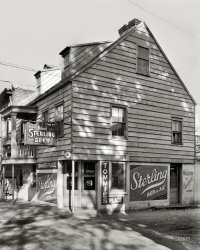
- Barefoot Bundle Boy
- August 1908. Cincinnati, Ohio. "Bundle carrier Sidney Ashcraft, 10 years old, 517 Hannibal ...
(The Gallery, Cincinnati Photos, Kids, Lewis Hine) ... Posted by Dave - 07/06/2019 - 4:53pm -
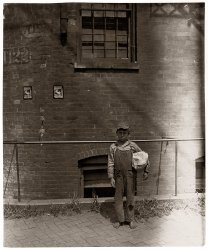
- Fourth From Race: 1900
- Cincinnati circa 1900. "Fourth Street looking east from Race." Compare and ... can make a difference in tech I guess.
(The Gallery, Cincinnati Photos, DPC, Stores & Markets) ... Posted by Dave - 11/09/2016 - 10:12pm -
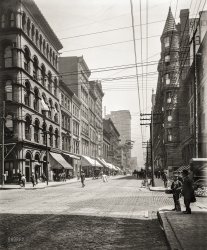
- Swing Time: 1955
- ... ball over the center divider. I think we called one game "Cincinnati" for some obscure reason.
We also had a circular exposed ... Posted by Dave - 05/24/2013 - 5:05pm -
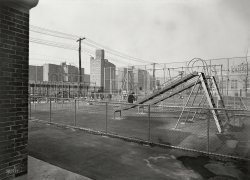
- G Street: 1925
- ... I would save my money and then ride the bus to downtown Cincinnati and go to an upstairs office similar to this one to purchase some ... Posted by Dave - 11/27/2013 - 12:18pm -
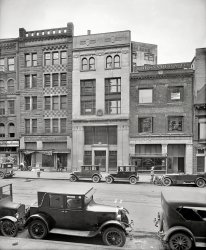
- Incubators of Doom: 1942
- February 1942. Cincinnati, Ohio. "A battery of 1,000- and 2,000-pound furnaces roaring threats ... this stuff on airplanes.
(The Gallery, Kodachromes, Cincinnati Photos, WW2) ... Posted by Dave - 08/30/2012 - 2:02pm -
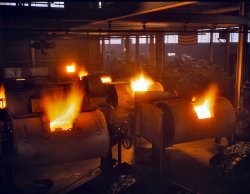
- Mount Adams Panorama: 1909
- Circa 1909. Cincinnati, Ohio, the Queen City, from Mount Adams: the two pictures stuck ... View full size.
(ShorpyBlog, Member Gallery, Cincinnati Photos) ... Posted by Alex - 08/08/2011 - 10:29pm -
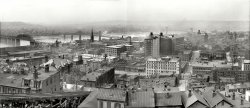
- Woman Police Concept: 1909
- ... in police uniform to illustrate woman police concept." Cincinnati, Ohio. September 23, 1909. View full size. George Grantham Bain Collection.
(The Gallery, Cincinnati Photos, Curiosities, G.G. Bain) ... Posted by Dave - 07/18/2011 - 1:03am -
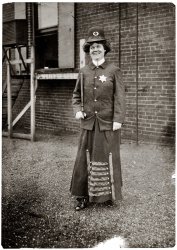
- The Winter of 65
- ... a collaboration between the the Crystal Bent Glass Co of Cincinnati and designer Walter Hentschel, known for his work with Rockwood ... Posted by Dave - 10/20/2017 - 10:19pm -
![The Winter of 65 October 1942. "Health measures for low indoor temperatures. Planning to spend a winter evening at home? Better dress for it the way these attractive government workers do, for homes will be kept to 65 degrees this year due to Federal fuel oil limitation orders. Slacks and warm robes mean comfort under lower temper­atures." Photo by Albert Freeman, Office of War Information. View full size.
Love the clockI'm more than confident one of us fellow Shorpyites will help me identifying the make and where I might be able to buy one?
Nothing better for low tempsThan a chenille bedspread.
“Limited” to 65 Degrees?Really? If my wife sets the thermostat to even a degree higher than that I start to break a sweat!
More importantMore important than where to buy one is what language are the hour numbers in? They almost look oriental but I doubt any one in 1942 would have a clock like that.
[Exotic Arabic. -Dave]
Whose Farm Bloc?It appears she's reading "Whose Farm Bloc?" by Arthur Moore from the October 12, 1942 issue of The New Republic.
Balmy TempsDuring the cold months, our mom kept the house at 61. The budget was tight and our rural house in northern Indiana had an inefficient oil furnace. As you'd imagine, the words "put on a sweatshirt" were repeated often. We were fine, especially with the warmth generated by cooking for a family of eight. That and sharing the body heat due to the close proximity of large family in a very small house. My own home is usually at a luxurious 65 in the winter.
Must ... have ... that clock The clock seems to have been a collaboration between the the Crystal Bent Glass Co of Cincinnati and designer Walter Hentschel, known for his work with Rockwood Pottery - and possibly the Waltham Clock Co of Waltham, Mass. More here.
(The Gallery, Albert Freeman, D.C., Pretty Girls, WW2)](https://www.shorpy.com/files/images/SHORPY-8b07651a.thumbnail.jpg)
- Next Stop: 2007
- ... during the 50 years of his career as an insurance agent in Cincinnati.
Born in Leavenworth, Kansas, on August 15, 1911, he lived part ... have practiced that profession. After working in downtown Cincinnati most of his career, he closed his business and retired at the age of ... Posted by Dave - 05/28/2010 - 11:37am -
![Next Stop: 2007 September 15, 1922. Clarence Sherrill, son of the Washington, D.C., superintendent of public buildings. National Photo Co. View full size.
Skate-a-mobileWhen I was a kid in the 40s and 50s, we used to make two versions of a thing we called a "skate-a-mobile". These were made from clamp-on roller skates. One skate was pulled apart so that one half became the front wheels and the other half the back.
The upright version was like a scooter. It had a footboard with wheels attached, and an upright at the front with a crosspiece nailed to it for handlebars.
The flat version had only the footboard, but with "handlebars" at the front. It was rather like a skateboard but we never used it that way. It was used in the manner that this picture shows, or headfirst if you were daring.
Helmet, what helmet?Let's not forget those hollow metal two-piece wheels from hell. On asphalt they would spark like flint and slide like skates...till they split in half and almost kill you.
The Inventor Of Street Luging?Not really, but if you've ever seen that crazy X-Games style sport you'd recognize the way Clarence is lying on whatever wheeled contraption he's lying on as a classic luger's posture. Of course these days he'd be wearing a helmet.
NecktieWas it Sunday? Or did he dress up for the picture? It is hard to imagine him wearing it every day.
[September 15 that year was a Friday. There was a lot more tie-wearing back then. - Dave]
Irony in ActionI wonder if he ever recalled this scene during the 50 years of his career as an insurance agent in Cincinnati.
Born in Leavenworth, Kansas, on August 15, 1911, he lived part of his youth in the Philippines where his father was stationed by the U.S. Army. Although he earned an engineering degree, he appears to never have practiced that profession. After working in downtown Cincinnati most of his career, he closed his business and retired at the age of 75 in 1986. He died at the age of 82 on December 24, 1993, and he was buried next to his wife in Glendale, Ohio's Oak Hill Cemetery.
His father, an engineering officer, eventually became a Brigadier General, and he was buried in Arlington National Cemetery. His younger sister was still living when this photo was originally published on Shorpy in 2007.
[We have more about Clarence here. - Dave]
(The Gallery, Kids, Natl Photo)](https://www.shorpy.com/files/images/07056u.thumbnail.jpg)
- Working on the Railroad: 1901
- ... The railroad nicknamed "Big Four" was the Cleveland, Cincinnati, Chicago and St. Louis Railway. CCC&StL.
Big Four again ... that way from its corporate title cities. Cleveland, Cincinnati, Chicago and St. Louis. The line was a subsidiary of the New York ... Posted by Dave - 02/16/2018 - 11:59am -
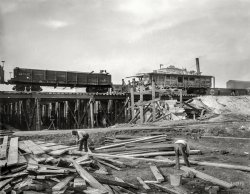
- CCC & StL: 1938
- ... car, side view, 3/7/38." Property of the Cleveland, Cincinnati, Chicago and St. Louis Railway. View full size.
Known as The ...
A Proud Member of the Big Four The Cleveland, Cincinnati, Chicago and St. Louis Railway was also known as New York Central's ... Posted by Dave - 02/17/2016 - 2:28pm -
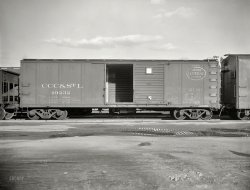
- Man of Letter: 1904
- ... and 60 Wall Tower, all in New York; Union Station in Cincinnati, the Trinidad Naval Air base and the Republic Steel plant in ... Posted by Dave - 01/23/2020 - 9:31am -
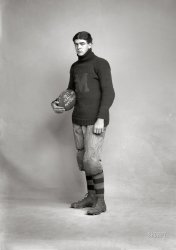
- An Exciting Moment: 1908
- An exciting moment at the Newsboys’ Picnic, Cincinnati. August 1908. View full size. Photograph by Lewis Wickes Hine.
(The Gallery, Cincinnati Photos, Kids, Lewis Hine) ... Posted by Dave - 07/29/2012 - 2:38pm -
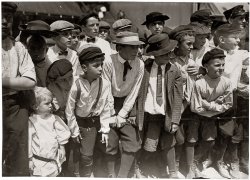
- Bus Triptych: 1943
- September 1943. Cincinnati, Ohio. "Loading baggage on a Greyhound bus at the bus terminal." ... for the money."
(The Gallery, Cars, Trucks, Buses, Cincinnati Photos, Esther Bubley) ... Posted by Dave - 02/24/2017 - 1:36pm -
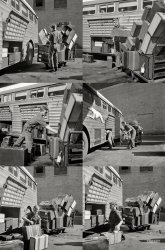
- Manned by Women: 1942
- ... they work. I had experience with that, too, operating a Cincinnati Bickford radial drill press (also of World War II vintage) for Brad ... for a couple of summers.
Old Grinder That is a Cincinnati centerless. I ran several for 30+ years. The wheel on the left is ... Posted by Dave - 06/01/2014 - 12:26pm -
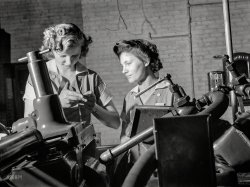
- Risky Business: 1915
- Cincinnati circa 1915. "Western & Southern Life Insurance Co., Fourth and ... very much there and so is the company.
(The Gallery, Cincinnati Photos, DPC) ... Posted by Dave - 07/09/2017 - 3:25pm -
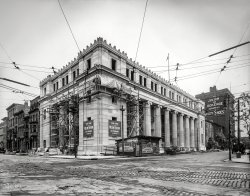
- Where's the Fire?
- ... This is a 1917 Ahrens-Fox Model K-1 fire engine (made in Cincinnati), manufacturer's serial number 645, originally of Engine Company 28 ... Posted by Dave - 08/29/2012 - 8:45pm -
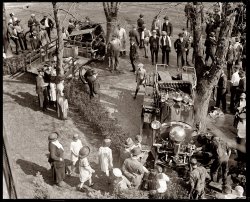
- Slim and Slimmer: 1923
- ... major leagues. Ewell Blackwell was 6 ft 6 and played for Cincinnati in the late 40's and early 50's. His best season was 1947 with 22 ... Posted by Dave - 03/29/2014 - 4:45pm -
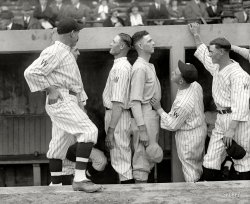
- Spanish Gallons: 1907
- ... arrows through the crossbow slots.
(The Gallery, Cincinnati Photos, DPC, S-A War, Streetcars) ... Posted by Dave - 10/02/2014 - 2:34pm -
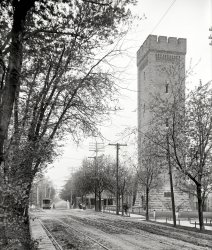
- Night Game: 194x
- ... New York circa 1940s. "Night baseball at Ebbets Field -- Cincinnati Reds vs. Brooklyn Dodgers." International News photo. View full ... If this is from that date this would be the game where Cincinnati pitcher Johnny Vander Meer threw the second of his two consecutive ... Posted by Dave - 01/17/2018 - 12:16pm -
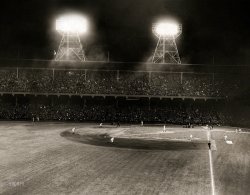
- Marie's Baskets: 1908
- Cincinnati, August 1908. "Marie Costa, basket seller, lives at 605 Elm Street. ... and caption by Lewis Wickes Hine.
(The Gallery, Cincinnati Photos, Kids, Lewis Hine) ... Posted by Dave - 07/16/2016 - 6:48pm -
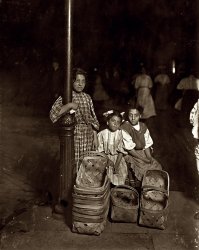
- Bricks, Mortar, Money: 1900
- Cincinnati circa 1900. "Lafayette and Franklin Banks and Masonic Temple, Third ... Publishing Co. View full size.
(The Gallery, Cincinnati Photos, DPC, Streetcars) ... Posted by Dave - 11/09/2016 - 11:47am -
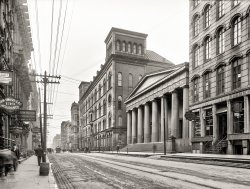
- Pain's Spectacle: 1905
- ... This libretto comes from the pyrodrama's appearance in Cincinnati in 1891.
Pain required a sizable down payment to bring the ... Posted by Dave - 04/09/2016 - 5:55pm -
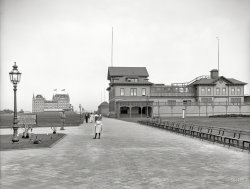
- Battle Wagon: 1921
- ... - Dave]
With Six You Get Bedroll I've lived in Cincinnati many decades, but the Sayers Six is a new one on me. Avondale was one of Cincinnati's plushest neighborhoods in the Twenties, so that was likely the ... Posted by Dave - 01/19/2019 - 10:12am -
![Battle Wagon: 1921 San Francisco circa 1921. "Sheridan touring car at Palace of Fine Arts." A product of the Sheridan Motor Car Co. of Muncie, Indiana, one of the more obscure entries in the Shorpy Catalog of Discontinued Conveyances. And evidently the buggy of choice for Civil War reenactors. Glass negative by Chris Helin. View full size.
Nothing Up His Sleeve It appears the Veteran Has an empty right sleeve.
[Except for the white thing coming out the end, which is his arm. - Dave]
Not Dead YetSayers and Scovill still exist as S&S Coach Company, outfitters of hearses and funeral limousines. They started building horse-drawn buggies, commercial wagons and funeral vehicles in 1876. They built the first motorized ambulance in 1906, and their first hearse automobile in 1912. Their only passenger car seems to be the Sayers Six in the picture, built from 1914 through 1924, with annual output rarely more than 200 per year. After that, they specialized in funeral vehicles. Although the company was sold several times, the brand remains active today.
The real thingI expect that the standup passenger is not re-enacting anything, but is a veteran of the conflict. The last veteran died about 35 years after the date of this picture, so having a live veteran was not unusual at the time.
[The fiftyish fellow with the spirit-gummed mustache isn't old enough. Below, actual Civil War veterans at Gettysburg in 1913. - Dave]
With Six You Get BedrollI've lived in Cincinnati many decades, but the Sayers Six is a new one on me. Avondale was one of Cincinnati's plushest neighborhoods in the Twenties, so that was likely the source of the car's model name.
(The Gallery, Cars, Trucks, Buses, Chris Helin, Civil War, San Francisco)](https://www.shorpy.com/files/images/SHORPY-318-02.thumbnail.jpg)
- Water Park: 1904
- Cincinnati circa 1904. "Reservoir and pumping station, Eden Park." 8x10 inch ... building is hidden behind some trees.
(The Gallery, Cincinnati Photos, DPC, Industry & Public Works) ... Posted by Dave - 07/02/2019 - 10:49am -
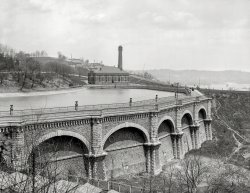
- Grease: 1925
- ... at Altoona, Bridgeville and Uniontown; Akron and Cincinnati, Ohio; Atlantic City and Woodbridge, New Jersey, Charlotte, Chicago, ... Posted by Dave - 10/22/2012 - 10:54am -
